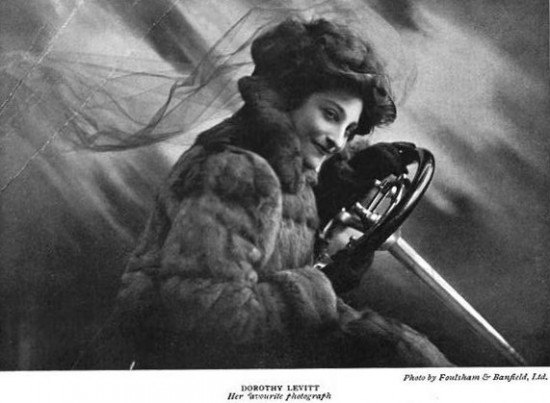Dorothy Levitt: The Woman And The Motor Car

She’s not particularly well known in the United States, perhaps because Alice Ramsey’s 1909 cross-continental motor car trip gets the lioness’ share of attention on this side of the Atlantic, but if you’re a car guy or a car girl, you should know about Dorothy Levitt (1882-1922), who was not only one of the first women to drive an automobile, she’s documented as being the first woman in England to race a car, 110 years ago.
While she tutored women in the skills needed to operate and maintain a brass era motor car, she had her own mentor, Selwyn Edge, Director of the Napier Car Company and an accomplished racing driver in his own right. She set her records in Napier cars and in Napier powered boats. Both Edge and Levitt understood the value of publicity and they had a mutually beneficial relationship, though Levitt was said to be shy and timid away from the public eye. The fact that Levitt, from contemporary accounts and from her photos, appears to have been a very attractive woman probably didn’t hurt her fame. Even with Edge’s influence, she still had to face obstacles because she was a woman. When the Brooklands racetrack first opened in 1907, they refused female entrants so she raced on the European continent instead.
Speaking of relationships, little is known about Levitt’s personal life. She died in 1922, at the age of 40, unmarried. From the date, it’s possible that she might have died of influenza, which was pandemic in the early 1920s.
I urge you to check out the Wikipedia entry on Levitt. With all the caveats that come with that source, that particular entry seems to be well written and properly cited enough. I don’t have to rewrite it into a little book report about it for you here. Go read about her, she’s an automotive personality you should know about.
Perhaps even stronger, I’d suggest that you read her book, available in its entirety at Google Books. Known as a “scorcher”, the turn of the 20th century term for what today we’d call a leadfoot, or a hoon, her personality comes through on every page. She simply loved to drive and going fast. In the book she mentions that she averaged driving about 400 miles per week. That’s more than most people drive today.
Ronnie Schreiber edits Cars In Depth, a realistic perspective on cars & car culture and the original 3D car site. If you found this post worthwhile, you can dig deeper at Cars In Depth. If the 3D thing freaks you out, don’t worry, all the photo and video players in use at the site have mono options. Thanks for reading – RJS

Ronnie Schreiber edits Cars In Depth, the original 3D car site.
More by Ronnie Schreiber
Latest Car Reviews
Read moreLatest Product Reviews
Read moreRecent Comments
- Buickman forget 5G, WiFi, microwaves, smart meters, and Bluetooth. (fluoride, chemtrails, clot shots)what does riding on a giant battery with ultra magnetic frequency do to your innards?oh, so an EV works for you not venturing far? YOU'RE NOT USING GAS!THERE'S NO FOOD IN THE DESERT!
- Buickman Who Killed the Electric Car?the buying public, that's who.
- MaintenanceCosts This is refreshing. Excess car storage which brainless local zoning rules forced the builders of this mall to include, but which normally sits empty, is actually being used for car storage!
- MaintenanceCosts Nice car if you can get it properly sorted, but the level of safety tech doesn't seem quite enough for a young driver on today's brodozer-infested highways.
- VoGhost OK. But if Subaru really wants this to sell, they'd make it as a PHEV with enough American content to get buyers $7,500 back on their federal taxes. Otherwise, this really doesn't stand out in a world of RAV4s and CR-Vs.



































Comments
Join the conversation
From wikipedia: "According to the reported statement by the police she was said to have driven at a "terrific pace" and, when stopped, reportedly said that '[she] ... would like to drive over every policeman and wished she had run over the sergeant and killed him.'" My type of gal.
Neat article, it reminds me my great-grandfather's teaching my grandmother and her sister to drive in the late 1910s. They would've been junior high aged, and the car would've either been a Chalmers or the Pierce-Arrow that replaced it (pretty high-end rides to entrust to 12-to-14-year-old girls). - - - The "Spanish flu" wouldn't have killed Ms. Levitt in '22. '18 and '19 were the big years, and there's debate as to whether or not it even continued into 1920. It petered out by '21.